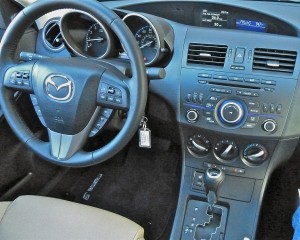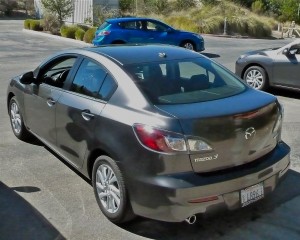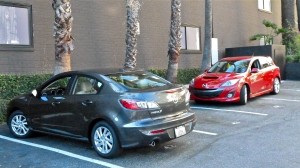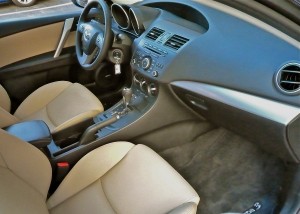Mazda3 shoots for the ‘Skyactiv’
By John Gilbert
HOLLYWOOD, CALIF. — Mazda’s new “Skyactiv†technology combines something old, a lot of new, and — without stepping on the tradition of the current Mazda3 — pulls off a complete holistic renovation of the company’s most successful model for 2012.
It is a signal of the modernization of Mazda’s car-building future, at the same time, because the Mazda3 compact represents 40 percent of all Mazda business in the U.S., where half of the 3-million-plus Mazda3s have been sold since the car replaced the Protege for the 2004 model year. The car underwent a full makeover for 2010, so the new model’s look is altered only slightly. But it is vastly changed beneath the skin.
To introduce the new car and its radical technology, Mazda chose the Hollywood Roosevelt Hotel, which, compared to the ultramodern locations usually chosen for new-car introductions, may have seemed an unusual site. But the hotel, like the car, has been completely renovated, with a unique combination of modern amenities while retaining a connection to the Roosevelt’s rich history, which is reflected on every floor and in every room. The hospitality suite Mazda used for the assembled auto journalists was, in fact, where Marilyn Monroe actually resided for three years. Reports persist that some guests in recent years have claimed that a room or two are occasionally visited by the friendly spirits of past residents.
Similarly, Mazda, which has a tradition of no-compromise performance, has completed the thorough renovation of the 2012 Mazda3 without losing touch with the car’s historic stature. Mazda’s all-consuming approach to modernizing the car upgrades Mazda3 fuel-efficiency to the 40-miles-per-gallon range rather than 30, while expanding its tradition of enjoyable and affordable performance. The look remains very similar, but the new and progressive Skyactiv technology alters its engines, transmissions, chassis structure, electronic connectivity features, aerodynamic efficiency on the outside, and improved ergonomics of the design inside.
Climbing inside both the Mazda3 sedan and hatchback, with both the stick and automatic, and driving down Hollywood Boulevard and up through the hills to Rochester Ranch, and back, gave us the opportunity to run the cars, and some competitors, through all the paces of urban, rural, mountain and freeway driving. Performance was typically quick and agile, the new engine and transmissions brought the tightness of the car to life, and the steering and suspension, and even the simplified instrumentation, seemed totally coordinated.
Mazda has never approached the hefty sales figures of Toyota, Honda or Nissan among its Japanese rivals, but its cars often attained better fuel economy and always have stressed being sportier to drive. Japanese manufacturers moved to the top of the industry with models capable of 30-miles-per-gallon a couple of decades ago. They might have been satisfied with that, leaving room for other companies, most notably Korea’s Hyundai, to lead the charge to make 40 the new 30 for contemporary gasoline-engine fuel economy potential. The Ford Focus and Fiesta, and the Chevrolet Cruze offer new models that will hit 40, forcing Honda, Toyota and Nissan to hustle out with special versions of current models to reach 40 with specially tweaked existing engines.
Ironically, Mazda, the company known more for performance than fuel economy, beat its more economy-minded Japanese contemporaries to the necessary giant step with the complete makeover of its engines and transmissions. The Skyactiv 2.0-liter 4 will be available in both 4-door sedan and 5-door hatchback, and both a new 6-speed automatic and 6-speed manual are offered in both versions.
The current 2.0 and optional 2.5 engines in the Mazda3 will continue to be offered in base Mazda3 vehicles, starting at $15,200, at least through the transition of production of Skyactive models, which are currently on their way to showrooms. A Mazda3 with Skyactive technology starts at $18,450 for the manual and $19,300 for the automatic, and the new technology is well worth the price hike.
The Skyactiv 2.0-liter 4-cylinder increases horsepower to 155 at 6,000 RPMs and torque to 148 foot-pounds at 4,800 RPMs, compared to the current 2.0 MZR engine’s figures of 148 and 135, respectively. The new 2.0 also reduces fuel consumption, and lessens CO2 emissions by 15 percent. EPA fuel estimates show the new Skyactiv Mazda3 in sedan form at 28 mpg city and 40 highway with the automatic, and 27/39 with the stick; the Skyactiv Mazda3 5-door hatchback shows 28/38 for the automatic, and 27/38 with the stick.
The larger 2.5-liter 4 has more power, with 167 horsepower and 168 foot-pounds of torque, but the Skyactiv 2.0 is lighter, more efficient, and perfectly plugs into Mazda’s new holistic overhaul.
Kenichiro Saruwatari, chief engineer on the new Mazda3, explained the Skyactiv engine’s technical obstacles and solutions, leading to a 21 percent improvement in gas mileage with the new 6-speed automatic, and an 18 percent improvement with the 6-speed manual. Increasing compression led to challenges such as engine knocking, caused by self-ignition from the heat and pressure of high-combustion designs. “Mazda’s plan lowers the temperature before combustion to reduce the time for knocking to develop,†Saruwatari said.
To capture more energy from combustion while losing less energy on its way to the wheels, The Skyactiv 2.0 uses a smaller bore (83.5 mm compared to 87.5 in the current 2.0), and a longer stroke to maintain the same 2.0 displacement. The smaller combustion chamber equals faster combustion, and less surface area of smaller-bore pistons means less heat loss, he said. Domed pistons created higher compression and more rapid combustion, but when the flame from combustion hit the top of the piston it increased heat and slowed combustion, so Skyactiv pistons have a small “combustion pocket†at the center to make room to contain the flame.
The air-fuel mixture is fed by direct injection, a costly technique that pays huge benefits. Mazda’s direct injection is pressurized to 2900 psi, and the spray is fed through a six-hole injection pattern on both intake and secondarily on combustion strokes. The engine also uses a Miller cycle method on both intake and exhaust valve camshafts, to leave the intake valves open longer to decrease in pumping loss, compared to conventionally closing the throttle.
“The intake valve timing is controlled electrically for faster response and wider adjustment range,†said Saruwatari. He added that with more efficient combustion, an improved exhaust was also required, and the 4-2-1 system proved most effective. The Skyactiv system sold on Mazda3s in Europe have a 14-to-1 combustion ratio but need premium 91-octane fuel, while the U.S. cars will have 12-to-1 combustion until the 4-2-1 exhausts are added to the system after production starts, which will improve the North American Skyactiv to 13-to-1 compression ratio on 87 octane regular.

Skyactiv improves engine power, fuel economy, handling, aerodynamics and even interior in holistic revision.
“The Skyactiv engine and transmissions were so impressive, I asked the engineers to improve the chassis just as much,†Saruwatari said. They did, adding more rigid cross-members, a brace bar, increased weld points, and increased B-frame thickness, from 0.9 to 1.6 mm.
Mazda also has taken a unique stride forward in its Skyactiv manual and automatic transmissions — both of which are wide-ratio 6-speeds. Many competitors are still using the 4- or 5-speeds that were state-of-the-art a decade ago, while more progressive companies such as Audi and Hyundai, and now Detroit’s Big Three, are coordinating new transmissions to extract optimum efficiency from their newest engines.
Mazda, not surprisingly, has gone its own route in gearbox technology, too. “Skyactiv is more a philosophy than strict engineering,†said Dave Coleman, who has used his sports car engineering background to develop the Skyactiv transmissions. “We were seeking an overall improvement of 30 percent in fuel economy, and we all were trying to do our parts. We ignored preconceived ideas, because they all had shortcomings.â€
Conventional automatics allow slippage when hard acceleration is sought, resulting in the sound of power long before actual power is locked up to be sent to the drive wheels, which is the reason alternative shifting systems have evolved. Coleman said that the newest trend is to direct-sequential manuals, which are clutchless automatics that have dual clutches inside that alternate gears for quicker and more direct shifting. “But DSGs are not good at low speed control, or for smooth, powerful launches,†he said.
Continuously variable transmissions (CVT) have a belt connecting two pulleys that vary the speed constantly. “CVTs are not good for high speed, or for direct feel or quick response, so we ruled CVTs out right away,†Coleman said. “And conventional automatics with planetary gears and torque converters are inefficient at low speed, and can be tuned for quick response or smoothness, but not both.â€
The Skyactiv 6-speed automatic uses both a torque converter that locks up at only 5 mph, plus a wet clutch, and a Mechatronic module to communicate between engine and transmission. The engineers met their targets. The torque-converter’s assets are used for smooth launches and intuitive low-speed control; eliminating torque-converter slippage above 5 mph improves efficiency and gives a direct connected feel, much like a manual for response; and designing Mechatronic’s to provide quick, responsive and smooth shifting.
“At Mazda, we wiped the slate clean, and started out with a conventional automatic with planetary gears, then set out to eliminate the blemishes, which are torque-converter slippage, indirect feel, slow shifting, and rough downshifts. We use both a clutch and torque-converter, which locks at 5 mph, because you must have some controlled slippage at low RPMs, but slippage is bad at higher speed.â€
The Skyactiv automatic hit all its objectives of a 15-millisecond downshift, measuring quicker than any competitor and the best DSG in 50-mph downshifts from sixth to fifth, sixth to third, fifth to fourth, and fifth to second.
For its manual, Mazda also equips the Skyactiv with a 6-speed, and it had its own benchmark for smoothness and precision with the Miata. Mazda redesigned every element of the new 6-speed stick for the front-wheel-drive Mazda3. Shorter internal shift travel and greatly reduced friction in the shift mechanism create a light and direct feel similar to the Miata. Re-engineering every internal part for lighter weight, smaller size and reduced friction even includes using a lower-viscosity oil.
Unlike many of its Japanese competitors, Mazda realizes that the trend toward close-ratio gearing, requiring constant shifting of the manual or the jerking of an automatic, foolish for real-world driving — to say nothing of optimum fuel economy. So Mazda spreads the gears out in both manual and automatic.
“For fuel economy, we wanted a wider spread on gears in the automatic,†said Coleman. “And because we wanted more torque, we chose taller gears without extremely close-ratio gears. That means the Skyactiv’s RPMs are much lower at freeway speed, for better fuel economy.â€
The 6-CD changer in the dash has been replaced by a single CD, with car owners going more to connected MP3 and iPod devices, and allowed blind-spot alert as a swap on the tech package without increasing prices.
Comments
Tell me what you're thinking...
and oh, if you want a pic to show with your comment, go get a gravatar!






 John Gilbert is a lifetime Minnesotan and career journalist, specializing in cars and sports during and since spending 30 years at the Minneapolis Tribune, now the Star Tribune. More recently, he has continued translating the high-tech world of autos and sharing his passionate insights as a freelance writer/photographer/broadcaster. A member of the prestigious North American Car and Truck of the Year jury since 1993. John can be heard Monday-Friday from 9-11am on 610 KDAL(www.kdal610.com) on the "John Gilbert Show," and writes a column in the Duluth Reader.
John Gilbert is a lifetime Minnesotan and career journalist, specializing in cars and sports during and since spending 30 years at the Minneapolis Tribune, now the Star Tribune. More recently, he has continued translating the high-tech world of autos and sharing his passionate insights as a freelance writer/photographer/broadcaster. A member of the prestigious North American Car and Truck of the Year jury since 1993. John can be heard Monday-Friday from 9-11am on 610 KDAL(www.kdal610.com) on the "John Gilbert Show," and writes a column in the Duluth Reader.